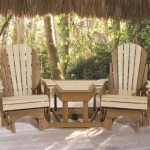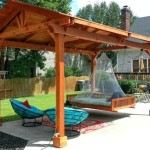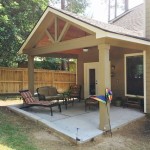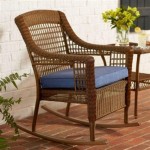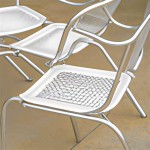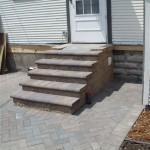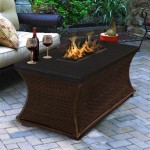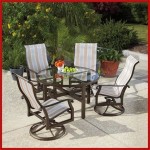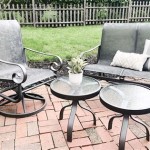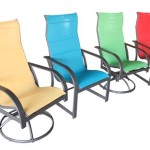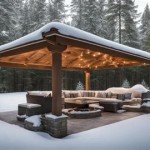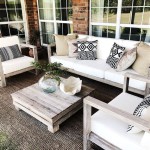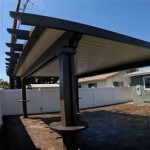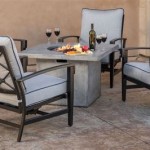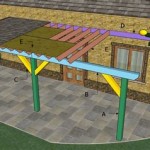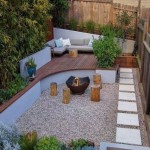```html
Outdoor Patio Furniture For Apartment Balcony: Maximizing Small Spaces
Apartment balconies, often overlooked as mere extensions of indoor living spaces, represent valuable opportunities to create functional and aesthetically pleasing outdoor retreats. Choosing the appropriate outdoor patio furniture for these compact areas necessitates careful consideration of size, material, functionality, and overall design, transforming a limited space into a relaxing oasis.
The selection process should begin with a thorough assessment of the balcony's dimensions. Precise measurements are crucial for determining the maximum furniture footprint that the space can comfortably accommodate without feeling cluttered or impeding movement. Overcrowding detracts from the intended purpose of the balcony, creating an environment that is more claustrophobic than inviting. Consider the door swing from inside the apartment as well, ensuring furniture doesn't obstruct entry and exit.
Beyond spatial constraints, the intended use of the balcony significantly influences furniture choices. A balcony primarily used for dining warrants a small table and chairs or a bistro set. Alternatively, a balcony intended for relaxation might benefit more from comfortable seating options like a loveseat, a couple of armchairs, or even a single chaise lounge. A hybrid approach, incorporating both seating and a small table, can cater to diverse needs, provided the space allows.
Material selection plays a critical role in the longevity and maintenance of balcony furniture. Exposure to the elements, including sunlight, rain, and fluctuating temperatures, demands durable and weather-resistant materials. The aesthetic appeal of the furniture should also complement the overall architectural style of the building and the personal preferences of the occupant.
Key Considerations for Selecting Balcony Furniture Materials
Choosing the right material is paramount for outdoor furniture, especially on an exposed balcony. The material directly impacts its durability, aesthetic, and maintenance requirements. Several popular options exist, each with inherent advantages and disadvantages.
Wicker & Rattan: Traditionally, wicker and rattan were natural materials, but modern outdoor furniture often utilizes synthetic wicker, typically made of polyethylene or PVC. Synthetic wicker offers superior weather resistance compared to natural rattan, being less susceptible to moisture damage, fading, and cracking. Natural rattan, while visually appealing, requires more diligent maintenance, including regular cleaning and protection from extreme weather conditions. Both natural and synthetic wicker create a relaxed, bohemian aesthetic and can be woven into various shapes and designs. However, synthetic wicker can sometimes appear less refined than natural materials.
Metal: Metal furniture, particularly aluminum and wrought iron, provides exceptional durability. Aluminum is lightweight, rust-resistant, and easy to maintain, making it an excellent choice for coastal environments. Wrought iron offers a more substantial and traditional aesthetic but requires regular painting or powder coating to prevent rust formation. Steel is another metal option, but it is heavier than aluminum and more prone to rust if not properly treated. Metal furniture is generally easy to clean and can withstand heavy use, but it can become hot in direct sunlight, necessitating the use of cushions.
Wood: Wood offers a natural and warm aesthetic, blending seamlessly with outdoor environments. Teak is a particularly popular choice for outdoor furniture due to its inherent resistance to moisture, insects, and decay. Other durable wood options include cedar, redwood, and acacia. However, all wood furniture requires regular maintenance, including cleaning, sealing, and staining, to prevent warping, cracking, and fading. Wood furniture can be heavier than other materials, offering stability in windy conditions, but it also requires more effort to move and store.
Plastic & Resin: Plastic and resin furniture offers affordability and low maintenance. Polypropylene and polyethylene are common plastic materials used in outdoor furniture manufacturing. These materials are lightweight, weather-resistant, and easy to clean. However, plastic furniture can be less durable than other materials, particularly in extreme temperatures. It may also fade or become brittle over time. Resin wicker, as previously discussed, is a more durable and visually appealing alternative to traditional plastic furniture.
In summary, the ideal material depends on individual preferences, budget constraints, and the specific environmental conditions of the balcony. Prioritizing durability and weather resistance ensures that the furniture will withstand the elements and provide years of enjoyment.
Maximizing Functionality in Small Spaces
The limited square footage of an apartment balcony necessitates maximizing functionality through clever furniture choices and space-saving strategies. Multifunctional furniture pieces, such as benches with built-in storage, folding tables, and stackable chairs, are invaluable for optimizing available space without sacrificing comfort or style.
Folding and Stackable Furniture: Folding tables and chairs offer unparalleled versatility for small balconies. These pieces can be easily folded and stored when not in use, freeing up valuable space for other activities. Stackable chairs are another excellent option, allowing for convenient storage and easy access when additional seating is required. Choosing lightweight materials further enhances the portability of these furniture pieces.
Storage Solutions: Incorporating storage solutions into balcony furniture is crucial for keeping the space organized and clutter-free. Benches with built-in storage compartments provide a convenient place to store cushions, gardening tools, or other outdoor accessories. Ottomans with removable lids can also serve as both seating and storage. Vertical storage solutions, such as wall-mounted shelves or planters, can further maximize space without occupying valuable floor area.
Multifunctional Pieces: Opting for furniture pieces that serve multiple purposes is an ingenious way to optimize space. A coffee table that doubles as a storage trunk, a bar cart that can be used for both serving drinks and storing barware, or a daybed that can function as both a sofa and a sun lounger are all excellent examples of multifunctional furniture. These pieces provide flexibility and versatility, allowing residents to adapt the balcony to different needs and activities.
Consider Vertical Space: Don't neglect the vertical dimension of the balcony. Trellises for climbing plants not only add visual interest but also create a sense of privacy. Hanging planters can be used to display flowers or herbs without taking up valuable floor space. Wall-mounted shelves can provide additional storage for books, candles, or other decorative items. Utilizing vertical space effectively can dramatically expand the functionality and aesthetic appeal of the balcony.
By carefully selecting multifunctional furniture pieces, incorporating storage solutions, and utilizing vertical space, apartment dwellers can transform their balconies into functional and inviting outdoor havens.
Design and Aesthetics: Creating a Welcoming Balcony Ambiance
Beyond functionality, the design and aesthetics of balcony furniture play a crucial role in creating a welcoming and relaxing outdoor ambiance. Coordinating furniture styles, colors, and accessories to reflect personal preferences and complement the overall architectural style of the building enhances the visual appeal of the balcony and fosters a sense of tranquility.
Color Palette: The color palette of balcony furniture and accessories profoundly influences the overall mood and atmosphere of the space. Light and neutral colors, such as white, beige, and gray, create a bright and airy feel, making the balcony appear more spacious. Bold and vibrant colors, such as turquoise, coral, or yellow, add a playful and energetic touch. Earth tones, such as brown, green, and terracotta, evoke a sense of nature and tranquility. Consider the existing color scheme of the apartment's interior and choose colors that complement it to create a cohesive and harmonious transition between indoor and outdoor spaces.
Style and Theme: Establishing a clear style or theme for the balcony furniture helps to create a unified and visually appealing space. A minimalist style emphasizes clean lines, simple shapes, and neutral colors. A bohemian style embraces eclectic patterns, textures, and vibrant colors. A rustic style incorporates natural materials, such as wood and stone, and emphasizes a sense of warmth and comfort. A modern style features sleek designs, geometric shapes, and contemporary materials. Selecting furniture and accessories that align with a specific style or theme creates a cohesive and intentional look.
Accessories and Decor: Accessories and decor are essential for adding personality and visual interest to the balcony. Cushions and throw pillows provide comfort and add splashes of color and pattern. Outdoor rugs define the seating area and create a cozy atmosphere. String lights or lanterns create a warm and inviting ambiance at night. Potted plants add greenery and life to the space. Decorative objects, such as sculptures, candles, or wind chimes, add character and individuality. Carefully selecting accessories and decor that complement the furniture and overall style of the balcony enhances its aesthetic appeal and creates a welcoming and personalized outdoor retreat.
Lighting Considerations: Lighting dramatically impacts the usability and ambiance of the balcony, especially during the evening hours. String lights, lanterns, and outdoor-rated lamps can create a soft and inviting glow. Solar-powered lights offer an energy-efficient and eco-friendly lighting solution. Consider the placement of lighting fixtures to create a balanced and well-lit space. Uplighting plants or architectural features can add depth and dimension. Dimmable lighting allows for adjusting the brightness to suit different moods and activities.
Transforming an apartment balcony into a stylish and inviting outdoor space requires careful attention to design and aesthetics. By coordinating furniture styles, colors, and accessories, and incorporating lighting and decorative elements, apartment dwellers can create a personalized and relaxing retreat that reflects their individual tastes and enhances their overall quality of life.
Ultimately, selecting the right outdoor patio furniture for an apartment balcony involves a multifaceted approach that balances practical considerations with aesthetic preferences. By carefully assessing space limitations, prioritizing functionality, choosing durable materials, and cultivating a cohesive design aesthetic, residents can transform their balconies into inviting and functional outdoor extensions of their homes, maximizing their enjoyment of limited spaces.
```
Use Small Balcony Furniture And Diy Your Way To A Beautiful Outdoor Space This Summer Mak Garden

26 Tiny Furniture Ideas For Your Small Balcony Design Patio Sets Outdoor Rooms

20 Wonderful Small Apartment Balcony Ideas For Outdoor Space Adria

Small Space Patio Outdoor Furniture Decor Crate Barrel

Balcony Décor Ideas Home Ca

Balcony Space Saver Folding Table

A Bohemian Bungalow Patio Makeover The Home In 2024 Balcony Furniture Decor Apartment

The Best Patio Furniture And How To For It Reviews By Wirecutter

Balcony Furniture For Apartment Dwellers Crush Outdoor Living

The Best Patio Furniture And How To For It Reviews By Wirecutter
See Also

